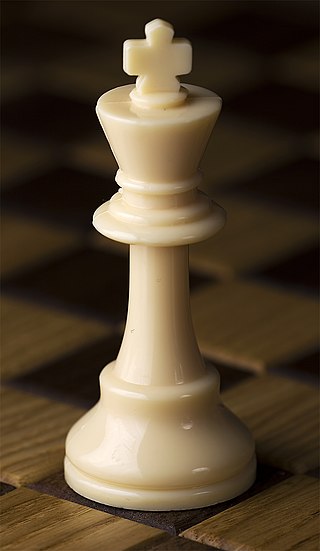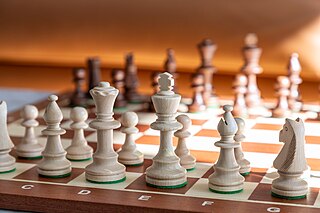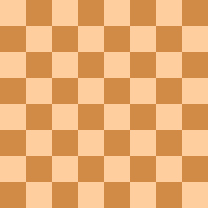Chess strategy is the aspect of chess play concerned with evaluation of chess positions and setting goals and long-term plans for future play. While evaluating a position strategically, a player must take into account such factors as the relative value of the pieces on the board, pawn structure, king safety, position of pieces, and control of key squares and groups of squares. Chess strategy is distinguished from chess tactics, which is the aspect of play concerned with the move-by-move setting up of threats and defenses. Some authors distinguish static strategic imbalances, which tend to persist for many moves, from dynamic imbalances, which are temporary. This distinction affects the immediacy with which a sought-after plan should take effect. Until players reach the skill level of "master", chess tactics tend to ultimately decide the outcomes of games more often than strategy. Many chess coaches thus emphasize the study of tactics as the most efficient way to improve one's results in serious chess play.

The king is the most important piece in the game of chess. It may move to any adjoining square; it may also perform, in tandem with the rook, a special move called castling. If a player's king is threatened with capture, it is said to be in check, and the player must remove the threat of capture immediately. If this cannot be done, the king is said to be in checkmate, resulting in a loss for that player. A player cannot make any move that places their own king in check. Despite this, the king can become a strong offensive piece in the endgame or, rarely, the middlegame.

A chess piece, or chessman, is a game piece that is placed on a chessboard to play the game of chess. It can be either white or black, and it can be one of six types: king, queen, rook, bishop, knight, or pawn.
In chess, a fork is a tactic in which a piece attacks multiple enemy pieces simultaneously. The attacker usually aims to capture one of the forked pieces. The defender often cannot counter every threat. A fork is most effective when it is forcing, such as when the king is put in check. A fork is a type of double attack.
In chess, a pin is a tactic in which a defending piece cannot move out of an attacking piece's line of attack without exposing a more valuable defending piece. Moving the attacking piece to effect the pin is called pinning; the defending piece restricted by the pin is described as pinned. Only a piece that can move any number of squares along a horizontal, vertical, or diagonal line can pin. Any piece can be pinned except the king. The pin is one of the most powerful chess tactics.
This glossary of chess explains commonly used terms in chess, in alphabetical order. Some of these terms have their own pages, like fork and pin. For a list of unorthodox chess pieces, see Fairy chess piece; for a list of terms specific to chess problems, see Glossary of chess problems; for a list of named opening lines, see List of chess openings; for a list of chess-related games, see List of chess variants; for a list of terms general to board games, see Glossary of board games.

Alice chess is a chess variant invented in 1953 by V. R. Parton which employs two chessboards rather than one, and a slight alteration to the standard rules of chess. The game is named after the main character "Alice" in Lewis Carroll's work Through the Looking-Glass, where transport through the mirror into an alternative world is portrayed on the chessboards by the after-move transfer of chess pieces between boards A and B.
A fairy chess piece, variant chess piece, unorthodox chess piece, or heterodox chess piece is a chess piece not used in conventional chess but incorporated into certain chess variants and some unorthodox chess problems, known as fairy chess. Compared to conventional pieces, fairy pieces vary mostly in the way they move, but they may also follow special rules for capturing, promotions, etc. Because of the distributed and uncoordinated nature of unorthodox chess development, the same piece can have different names, and different pieces can have the same name in various contexts.
Madrasi chess is a chess variant invented in 1979 by Abdul Jabbar Karwatkar. The game uses the conventional rules of chess with the addition that when a piece is attacked by a piece of the same type but opposite colour it is paralysed and becomes unable to move, capture or give check.
In the game of chess, interference occurs when the line between an attacked piece and its defender is interrupted by sacrificially interposing a piece. It is a chess tactic which seldom arises, and is therefore often overlooked. Opportunities for interference are rare because the defended object must be more valuable than the sacrificed piece, and the interposition must itself present a threat. Huczek defines interference as a tactic involving blocking moves that obstruct lines of attack. This definition may be expanded by including blocking moves that disrupt lines of defense.
In chess, a tactic is a sequence of moves that each makes one or more immediate threats – a check, a material threat, a checkmating sequence threat, or the threat of another tactic – that culminates in the opponent's being unable to respond to all of the threats without making some kind of concession. Most often, the immediate benefit takes the form of a material advantage or mating attack; however, some tactics are used for defensive purposes and can salvage material that would otherwise be lost, or to induce stalemate in an otherwise lost position.
In chess and similar games, check is a condition that occurs when a player's king is under threat of capture on the opponent's next turn. A king so threatened is said to be in check. A player must get out of check if possible by moving the king to an unattacked square, interposing a piece between the threatening piece and the king, or capturing the threatening piece. If the player cannot remove the check by any of these options, the game ends in checkmate and the player loses. Players cannot make any move that puts their own king in check.
In chess, a pure mate is a checkmate position such that the mated king is attacked exactly once, and prevented from moving to any of the adjacent squares in its field for exactly one reason per square. Each of the squares in the mated king's field is attacked or "guarded" by one—and only one—attacking unit, or else a square which is not attacked is occupied by a friendly unit, a unit of the same color as the mated king. Some authors allow that special situations involving double check or pins may also be considered as pure mate.
In chess, an isolated pawn is a pawn that has no friendly pawn on an adjacent file. Isolated pawns are usually a weakness because they cannot be protected by other pawns. The square in front of the pawn may become a good outpost for the opponent to anchor pieces. Isolated pawns most often become weaker in the endgame, as there are fewer pieces available to protect the pawn.
In chess, an exchange or trade of chess pieces is a series of closely related moves, typically sequential, in which the two players capture each other's pieces. Any type of pieces except the kings may possibly be exchanged, i.e. captured in an exchange, although a king can capture an opponent's piece. Either the player of the white or the black pieces may make the first capture of the other player's piece in an exchange, followed by the other player capturing a piece of the first player, often referred to as a recapture. Commonly, the word "exchange" is used when the pieces exchanged are of the same type or of about equal value, which is an even exchange. According to chess tactics, a bishop and a knight are usually of about equal value. If the values of the pieces exchanged are not equal, then the player who captures the higher-valued piece can be said to be up the exchange or wins the exchange, while the opponent who captures the lower-valued piece is down the exchange or loses the exchange. Exchanges occur very frequently in chess, in almost every game and usually multiple times per game. Exchanges are often related to the tactics or strategy in a chess game, but often simply occur over the course of a game.
Omega Chess is a commercial chess variant designed and released in 1992 by Daniel MacDonald. The game is played on a 10×10 board with four extra squares, each added diagonally adjacent to the corner squares. The game is laid out like standard chess with the addition of a champion in each corner of the 10×10 board and a wizard in each new added corner square.

In chess, checkmate pattern is a recognizable/particular/studied arrangements of pieces that delivers checkmate. Several checkmate patterns occur frequently enough to have acquired specific names in chess commentary. The diagrams that follow show these checkmates with White checkmating Black.
In chess, a skewer is an attack upon two pieces in a line and is similar to a pin. A skewer is the opposite of a pin; the difference is that in a skewer, the more valuable piece is the one under direct attack and the less valuable piece is behind it. The opponent is compelled to move the more valuable piece to avoid its capture, thereby exposing the less valuable piece which can then be captured. Only line pieces can skewer; kings, knights, and pawns cannot.

The following outline is provided as an overview of and topical guide to chess:
Many basic tactics of shogi are similar to those of chess tactics, involving forks, pins, removing the defender and other techniques, all of which are considered very strong when used effectively.





